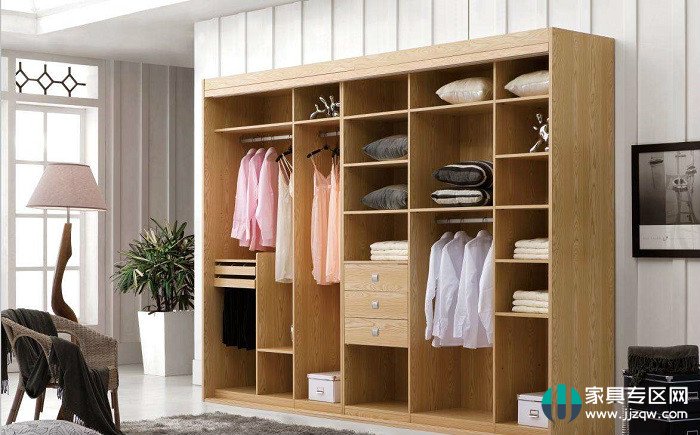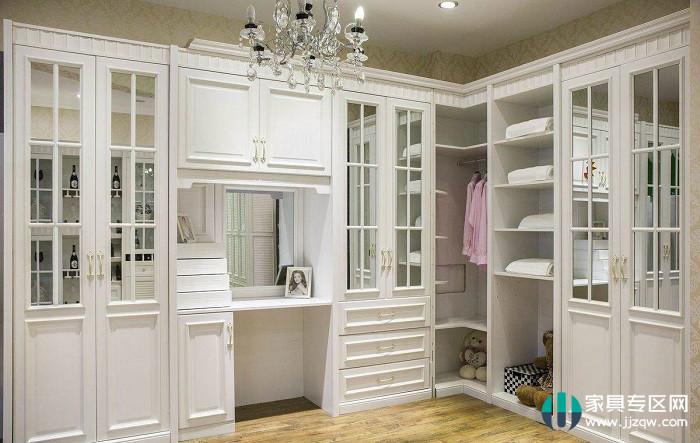The wardrobe on the market can not meet your needs? Then

The size of the wardrobe is not designed, there will be a lot of troubles in use, such as no place to put a quilt, a small foot to get clothes, etc.
Many wardrobes on the market can't meet their own needs, so find a master to do one.
In fact, it is not so difficult to build a wardrobe that fits your height and usage habits. The layout and size of common wardrobes are as follows:
Wardrobe size
Different from the finished wardrobe, the general custom wardrobe is designed with the top of the wall, and the total height of the wardrobe is basically not designed.
Leave the bottom of the 70mm high baseboard for moisture and heat insulation, and the rest is the height of the wardrobe.
The widest men's coat is about 600mm wide, so the depth of the general wardrobe is between 550-600mm. Apart from the wardrobe back panel and the wardrobe door, the depth of the whole wardrobe is between 530-580mm. This depth is more suitable for hanging clothes. It won't cause wrinkles in the clothes because the depth is too shallow. The space for hanging clothes will not feel too narrow.
The interior layout of the wardrobe generally needs to be divided into several areas:
1. The reclamation area:
Depending on the usual height of the quilt, this area is usually 400-500 mm high and 900 mm wide. This space is mainly for storing quilts that are not used for seasons. Because it is inconvenient to take items, it usually makes the upper end of the closet a bedding area, which is also good for moisture prevention.
2, stacking area:
This area can be designed as an adjustable movable layer, which can be changed according to the needs of the height or changed to other areas. For example, when the clothes are increased, the clothes rail can be changed to the top area. This area is mainly used for stacking sweaters, T-shirts, casual pants and other clothing. It is best to arrange it in the area between the waist and the eyes for easy access. According to the width of the general clothing after folding, the cabinet width should be between 330-400mm and the height is 350-400mm.
It is not too high to remove the plaid outside the storage quilt. It is too high to be basically wasted. It is difficult to avoid messing up when the clothes are stacked more than 5 pieces. Therefore, it is not as good as the plaid and shorter.
3. Long clothing area:
It is measured according to the longest long dress, generally 1400-1500mm, not less than 1300mm. The long-sleeved area is mainly used for hanging long-sleeved clothes such as windbreakers, down jackets, overcoats, dresses, and dresses. The width of the long dress area can be designed according to the number of pieces of long clothes that you own. It is usually 450mm wide and can be used by one person. If more people use it, they can be widened or designed with multiple dressing areas. In addition, if the space is not particularly tight, it is recommended to choose a depth of 600mm, so that the clothes are more comfortable.

How many short clothes are there at home? Then you need a hanging jacket area.
1. Tops area
Used to hang a blouse that is easy to wrinkle, such as a suit, shirt, or jacket. The top area is 1000-1200mm high. According to the normal length of the clothes, the clothes should not be dragged to the bottom of the board. Also note that depending on the height of the individual, the distance from the clothes rail to the ground should not exceed 1800mm, otherwise it is not convenient to take.
The hanging area, the clothes rail and the top of the cabinet should not be less than 60mm, otherwise it is not convenient to take the hanger.
2, drawer:
The general size is 400-800mm wide and 190mm high. This area is mainly used for storing underwear. Generally, 3 or 4 drawers are designed under the top area, which is mainly used for storing underwear. According to the height of the underwear rolled up, the height of the drawer can not be lower than 190mm, otherwise it is easy to clamp the clothes when closing the drawer.
3, the lattice frame:
The height of the lattice frame is between 160 and 200 mm. This area is mainly used for storing ties. Since there are clips for fixing the tie, there is no need for too much space.
4, pants rack
High 800-1000mm. The trousers rack is designed for hanging pants and is not easy to wrinkle. All trousers are folded up and down, so the distance from the hanging rod to the bottom plate should not be less than 600mm, otherwise the trousers will be dragged onto the bottom plate. It is recommended to buy a wardrobe with non-slip pants to prevent the pants from falling; while the pants are easy to fall.
Note: If the wardrobe is placed on the side of the wall corresponding to the bed, then the distance between the two pieces of furniture should be greater than 900mm, otherwise it is inconvenient to open the door, but if the sliding door is used in the large wardrobe, there is no such problem, the distance can be Smaller
Poly l lactic acid is a synthetic Dermal Filler that is injected into your face, causing your body's own production of collagen. This type of dermal filler is known as a stimulator. This non-toxic, biodegradable substance has been used for more than 40 years as suture material.
As we age, the fat, muscles, bone, and skin in our face begins to thin. This loss of volume leads to either a sunken or sagging appearance of the face. Injectable poly-l-lactic acid is used to create structure, framework, and volume to the face. PLLA is known as a bio-stimulatory dermal filler, this means it stimulates your own skin to produce new collagen. Over time your skin breaks down PLLA into water and carbon dioxide. The effects of PLLA appear gradually over a few months, producing natural results.
What should first be done before considering injectable poly-l-lactic acid?
First, an dermatologist will review the patient`s medical history and examine the condition to be treated. Areas to be treated should be kept clean. If there is a skin infection, then treatment needs to be postponed until it resolves. Patients who take blood thinners (such as aspirin, ibuprofen, certain herbal medications) should stop them two weeks prior to injection with the approval of their prescribing doctor.
Your doctor will evaluate the areas of your face needing improvement in structure and/or volume. Topical or injection numbing medication may be used for added comfort prior to your procedure. For additional patient comfort lidocaine, an anesthetic, is mixed with PLLA prior to the treatment. Using a syringe, poly-l-lactic acid is injected into the hollow areas of your face and/or areas requiring improved structure. Multiple treatment sessions with PLLA are needed which are often spaced at one month intervals. The effects of PLLA typically last up to 24 months. After that, additional injections are required to maintain the effect.
Is injectable poly-l-lactic acid painful?
Topical numbing agents or anesthetic injections are sometimes applied to ease discomfort. Also, lidocaine is commonly added to PLLA for improved patient comfort. Before and following treatment, ice may be given to ease discomfort and swelling. Patients are encourage to massage the treatment areas for the first 5 days, 5 times a day, for 5 minutes each. We call this the 5-5-5 rule.
What can I expect after having had PLLA?
PLLA fillers are temporary, lasting up to two years, depending on the patient. Most patients require maintenance treatments to achieve the best results.
Face Filler Injections,Hyaluronic Acid Fillers,Hyaluronic Acid Injection, Fillers for Jawline
Rimless Industry Co.,Ltd. , https://www.rimlessmedbeauty.com